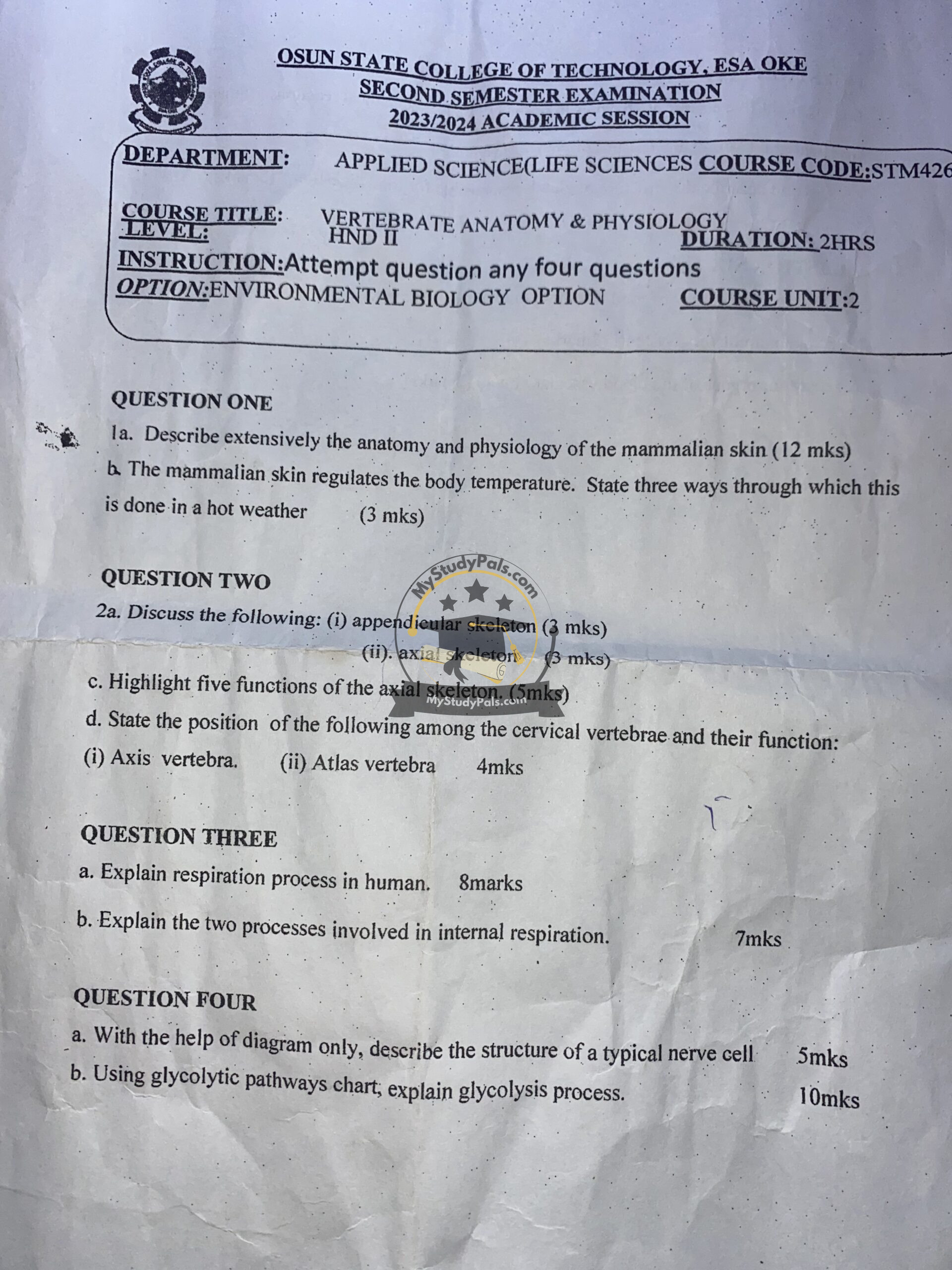ANSWER
QUESTION ONE:
1a. Describe extensively the anatomy and physiology of the mammalian skin (12 marks)
Answer:
The mammalian skin is a complex organ that serves multiple functions, including protection, sensation, and temperature regulation. It consists of three main layers:
- Epidermis:
- The outermost layer composed of keratinized stratified squamous epithelium.
- It contains melanocytes responsible for skin pigmentation and Langerhans cells for immune defense.
- Functions as a protective barrier against pathogens, UV radiation, and dehydration.
- Dermis:
- Lies beneath the epidermis and consists of connective tissue, blood vessels, lymphatic vessels, nerve endings, and hair follicles.
- Houses sebaceous (oil) glands, sweat glands, and collagen fibers, which provide strength and elasticity.
- Contains sensory receptors for touch, pain, temperature, and pressure.
- Hypodermis (Subcutaneous Layer):
- Composed of adipose tissue and connective tissue.
- Acts as insulation, stores energy, and cushions internal organs.
The physiology of mammalian skin includes temperature regulation, excretion, sensory perception, and synthesis of vitamin D.
1b. The mammalian skin regulates body temperature. State three ways through which this is done in hot weather (3 marks)
Answer:
- Sweating: Sweat glands produce sweat, which evaporates and cools the body.
- Vasodilation: Blood vessels in the skin widen, increasing blood flow and heat dissipation.
- Decreased Hair Erection: Reduced activity of arrector pili muscles minimizes insulation, allowing heat loss.
QUESTION TWO:
2a. Discuss the following:
(i) Appendicular skeleton (3 marks)
Answer:
The appendicular skeleton consists of bones that support the limbs and allow movement. It includes:
- Pectoral girdle (shoulder bones): Clavicle and scapula.
- Upper limbs: Humerus, radius, ulna, carpals, metacarpals, and phalanges.
- Pelvic girdle (hip bones): Ilium, ischium, and pubis.
- Lower limbs: Femur, tibia, fibula, tarsals, metatarsals, and phalanges.
Its primary function is movement, attachment of muscles, and support of the body’s weight.
(ii) Axial skeleton (3 marks)
Answer:
The axial skeleton consists of bones forming the central structure of the body, including:
- Skull: Protects the brain and houses sensory organs.
- Vertebral column: Composed of cervical, thoracic, lumbar, sacral, and coccygeal vertebrae; supports the body and protects the spinal cord.
- Rib cage: Consists of ribs and the sternum, providing protection for vital organs like the heart and lungs.
Its primary function is protection and structural support.
2c. Highlight five functions of the axial skeleton (5 marks)
Answer:
- Protection of vital organs (e.g., skull protects the brain, rib cage protects the heart and lungs).
- Support and posture maintenance by providing a framework for the body.
- Attachment site for muscles, enabling movement.
- Hematopoiesis, as bone marrow in certain axial bones produces blood cells.
- Facilitates movement through articulation with the appendicular skeleton.
2d. State the position of the following among the cervical vertebrae and their function:
(i) Axis vertebra (2 marks)
Answer:
- Position: Second cervical vertebra (C2).
- Function: Allows rotation of the head due to the presence of the odontoid process (dens).
(ii) Atlas vertebra (2 marks)
Answer:
- Position: First cervical vertebra (C1).
- Function: Supports the skull and allows nodding (up and down) motion of the head.
QUESTION THREE:
3a. Explain the respiration process in humans (8 marks)
Answer:
Respiration is the biological process in which oxygen is inhaled and used for energy production, while carbon dioxide is exhaled. The process occurs in the following steps:
- Inhalation (Inspiration):
- The diaphragm and intercostal muscles contract, increasing thoracic cavity volume.
- Air enters the lungs through the nose, pharynx, larynx, trachea, bronchi, and bronchioles to reach the alveoli.
- Gas Exchange in Alveoli:
- Oxygen diffuses from alveoli into the bloodstream, binding with hemoglobin in red blood cells.
- Carbon dioxide from the blood diffuses into alveoli to be exhaled.
- Cellular Respiration:
- Oxygen is utilized in mitochondria to produce ATP (energy) through glycolysis, the Krebs cycle, and oxidative phosphorylation.
- Exhalation (Expiration):
- The diaphragm and intercostal muscles relax, decreasing thoracic cavity volume.
- Carbon dioxide is expelled from the lungs.
3b. Explain the two processes involved in internal respiration (7 marks)
Answer:
- Gas Exchange at the Tissue Level:
- Oxygen from red blood cells diffuses into body tissues for cellular metabolism.
- Carbon dioxide produced in cells diffuses into the blood for transport to the lungs.
- Cellular Respiration:
- Cells use oxygen to break down glucose, producing ATP and releasing carbon dioxide as a byproduct.
- This occurs through glycolysis, the Krebs cycle, and the electron transport chain in mitochondria.
QUESTION FOUR:
4a. With the help of a diagram only, describe the structure of a typical nerve cell (5 marks)
Answer:
[Here, you should provide a labeled diagram of a neuron, showing:]
- Cell body (soma): Contains nucleus and organelles.
- Dendrites: Receive signals from other neurons.
- Axon: Conducts electrical impulses.
- Myelin sheath: Insulates the axon for faster signal transmission.
- Axon terminals: Transmit signals to other neurons or muscles.
4b. Using glycolytic pathways chart, explain the glycolysis process (10 marks)
Answer:
Glycolysis is the metabolic pathway that breaks down glucose into pyruvate, producing ATP and NADH. It occurs in the cytoplasm and involves the following steps:
- Energy Investment Phase:
- Glucose (6C) is phosphorylated using ATP, forming glucose-6-phosphate.
- Converted to fructose-6-phosphate and further phosphorylated to fructose-1,6-bisphosphate.
- Splits into two molecules of glyceraldehyde-3-phosphate (G3P).
- Energy Payoff Phase:
- G3P is oxidized, producing NADH and ATP.
- Phosphoenolpyruvate (PEP) is converted to pyruvate, generating additional ATP.
Final Products:
- Net ATP Yield: 2 ATP molecules per glucose.
- Byproducts: 2 NADH and 2 pyruvate molecules.
- Fate of Pyruvate: Under aerobic conditions, it enters the Krebs cycle; under anaerobic conditions, it undergoes fermentation.


